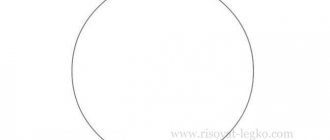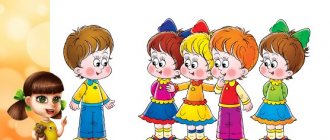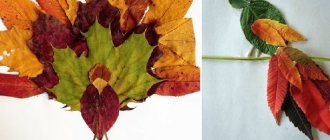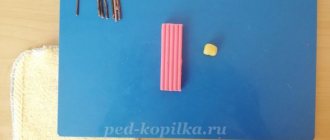Middle group. Junior preschool age. Children 4 - 5 years old
Open lesson in mathematics “Skills of forward and backward counting to 10” in the middle group Summary of a lesson in mathematics in the middle group. Goal: to consolidate the skills of counting forward and backward to 10, the ability to navigate on the plane of a sheet of paper, to consolidate knowledge about flat and three-dimensional geometric figures, to select objects similar to three-dimensional geometric shapes. figures...
Summary of an open lesson for Mother's Day in the middle group Summary of educational activities in the middle group on the topic: "Mother's Day"
Progress of
the lesson : Vera: Hello guys! To understand who we are going to talk about today, guess the riddle: Who came to me in the morning? Who said: “It’s time to get up? “Who managed to cook the porridge? Should I pour some tea into my mug? Who braids me...
Summary of an open comprehensive lesson in kindergarten (middle group)
Summary of an open comprehensive lesson in kindergarten (middle group)
Program tasks
Exercise children in counting within 10. Test their knowledge of the first ten numbers. Develop an understanding of geometric bodies (ball, cube, cylinder, cone). Strengthen children's ability to draw using non-traditional methods (cotton swabs, cork impressions). Learn on your own, create a pattern.
Activate children's mental activity, develop logical thinking and intelligence. Learn to foster joint discussion, search for and find an answer. Develop the ability to quickly get involved in the active preparatory process. Develop analytical perception, sustained attention, memory, speech. Learn to take a creative and proactive approach to solving problems. Develop aesthetic perception and imagination. Create surprise and novelty in the environment.
Materials
Part I:
- Magic wand.
- Whatman paper and markers.
- 2 colored paper wheels for the car.
- Driver's steering wheel.
- A clearing with flowers, there are riddles on the flower petals.
- 3 hoops and geometric bodies (Cube, ball, cone, pyramid, cylinder).
- Audio recordings: a) children's song: “We are going, going, going...”; b) “Russian folk melodies”.
Part II:
- Screen, doll. (Ivan Tsarevich)
- Planar image of the “Firebird”.
- Feather samples with pattern elements (3 pieces).
- Gouache in three colors (orange, red, crimson).
- Cotton buds. Corks, brush “Squirrel” No. 2.
- Napkins for drawing.
- Jars of water.
- Brush holders.
- Sockets with foam insert, impregnated with gouache.
- Sheets of yellow paper in the shape of bird feathers.
PROGRESS OF THE CLASS
The day before the group received an invitation from Ivan Tsarevich.
Educator:
Children, we have received an invitation from Tsarevich Ivan. Let's go to him.
Educator
: Look, guys!
There's a strange map here. It only shows dots, if we can connect the dots with lines in order, then we will understand something .
(Children connect the dots to create an image of a car)
Picture 1
Educator:
We'll hit the road by car! Let's choose a driver using a little counting rhyme:
(Children count and choose a driver)
Educator:
Go!
(Music “We’re going, we’re going, we’re going”…)
Educator:
Children, where have we ended up? Who will tell us?
Voice:
You have reached the lawn of “Riddles”. I am the owner of this lawn. You must guess all the riddles on my flowers. Only then will you be able to go to Ivan Tsarevich.
(Children find riddles on the petals)
On a red flower:
- The elephant is big, and the mouse...
- The pillow is soft, and the table...
- The tree is tall. And the grass...
- The river is wide, and the stream...
- Ice is cold and fire...
- The floor is below and the ceiling...
On a yellow flower:
- Say a sweet word.
- Fast.
- Word with a window.
- Fluffy.
- Sour.
- Lesnoye.
Lawn owner:
Well done! Now try to guess my riddles. What word did I have in mind?
- White spins and falls to the ground...
- Brown, club-footed, clumsy...
- Small, gray, timid, lives in a hole...
- Sweet, tasty in a wrapper...
Educator:
Now, our children will try to tell you a riddle, and you try to guess it.
(Children come up with and make riddles themselves, the owner of the lawn must guess them)
Lawn owner:
You completed the task well, you can move on!
(Children get into the car and drive on, music sounds)
Educator:
Children, we are probably in the wrong place again, Tsarevich Ivan is not here.
Voice:
You have found yourself in a clearing of geometric bodies. I am the boss here, and you must cope with my tasks.
Game description:
Each geometric body must fall into a hoop of the corresponding color, where the hoops intersect there may be bodies of two colors.
Game: “Find a place for a geometric body”
Figure 2
The owner of the clearing:
Well done, children! We completed my assignments. Now you can go to Ivan Tsarevich! Bon Voyage.
Educator:
So we got to Ivan Tsarevich!
(Showing a doll from behind a screen, sad)
Educator:
Children, here he is. He's not funny at all. Let's ask him what happened.
What, Ivanushka is not cheerful, what, has he hung his head?
Ivan Tsarevich:
I stopped eating and sleeping. I wish I could get the firebird. That bird lost a feather when it flew in our garden. Pen, I picked this up, Since then I have lost peace. I had already worn out all my shoes, but I couldn’t find the Firebird.
Educator:
Don’t worry, Ivanushka, trouble is no big deal! You, my friend, ended up in kindergarten and you are visiting the guys. Vanya, we’ll help you, it’s no good for you to grieve.
Educator:
The guys and I saw this bird in a fairy-tale kingdom-state, and there it is! Look Ivanushka, isn't it her you're looking for?
(The teacher shows a bird that has no feathers on its tail)
Ivan Tsarevich:
No, this bird is not mine. Mine had a bright, beautiful tail.
Educator:
And this is not a problem. Our children will help you.
Guys, look at the table in front of you one feather at a time, we will decorate them with various patterns, and then from all the feathers we will assemble a beautiful, bright tail for the Firebird.
(Go to your seats, sit down)
On your tables are: corks, brushes and cotton swabs. You already know and can draw wonderfully with them. Think about which tool you will need to work with first and which later, and what color you want to leave on the feathers. If you take the corks, you might end up with a pattern like this. Then you take a cotton swab and your pattern will change. Then you take a brush and complete your design. I got this feather.
Figure 3
(Children draw, music plays, the teacher corrects the children’s actions)
Educator:
What kind of feathers did you get? Let's look at them! Now we will decorate the tail of the Firebird with your elegant feathers.
(As the children finish their work, each child comes up and puts a feather to his tail, the teacher positively evaluates the work of each child)
Educator:
Ivanushka, look what our children have accomplished! Do you like Firebird?
Ivan Tsarevich:
Thank you for being friendly, what a bird they got me. She will not live in a cage, but sit on a branch in the garden. He will sing songs and decorate the magical garden.
Educator:
That’s good, Ivan Tsarevich, we helped you. It's time for us to return to kindergarten. Goodbye, Ivan Tsarevich!
Figure 4
Summary of educational activities in the secondary group “Forest Mathematics”.
Summary of educational activities in the middle group
"Forest Mathematics".
Dominant educational area: cognitive development.
Type of children's activities: cognitive - research activities, communicative, gaming.
Methods and techniques for implementing the lesson content:
Verbal:
- artistic expression: nursery rhymes, poems.
- a leading question: how many trees are there in the clearing! Guys, do you know what they are called? (Children's answers).
- problematic situation: mushrooms for the squirrel.
— verbal instruction: find a similar geometric figure.
Visual:
-examination of illustrations and natural material: cards with images of animals and mushrooms, natural material – pine cone.
Practical:
— finger gymnastics “Pine Cone’s Journey”
— didactic exercise: “Wonderful bag”
- productive activity (sculpting): “Mushroom for a squirrel”
Integration of educational areas: “Physical development”, “Social and communicative development” , “Artistic and aesthetic development”, “Speech development”.
Goal: To form mathematical concepts and sensory standards in children.
Tasks:
1) Teach quantitative counting up to 5.
2) Learn to compare objects by length and height.
3) Learn to denote in words the position of an object in relation to oneself.
4) Develop the ability to distinguish and name geometric shapes: triangle, circle and square.
5) Cultivate a friendly attitude towards animals and a desire to help them.
Organization of a developmental environment for conducting classes (educational activities)
The group contains models of a forest clearing (trees, paths with animal tracks, a carpet clearing, wonderful bags with geometric shapes, a basket with pine cones); train layout from geometric shapes (triangle, square, circle, oval); toys (bear, fox, squirrel); handouts for work (plasticine and boards) are placed on the tables; installed screen, computer, magnetic board; organization of musical accompaniment; pictures with images (animals, train, cones, mushrooms of different sizes).
OD progress
Educator : Good morning, guys!
Children: Good morning!
Educator: What a wonderful day today is for a walk, and I suggest you go to the forest! Want to?
Children: Yes!
Educator: But the forest is far away. What transport can you use? (Children's answers). I suggest taking a ride on the magical geometric train.
Educator: Look at what geometric shapes the train cars are made of (triangle, circle, square, oval). But in order to travel on the magic train, you need to get tickets and then take a seat according to the ticket. (Hand out tickets. Tickets correspond to a carriage with a certain geometric figure.) Look carefully at your tickets. What do they show? (Children's answers) You need to sit in the carriage that depicts the same figure as the one on your ticket. (Questions for children: why did you get into a carriage with a triangle, a circle, a square?) Raise your tickets, I’ll see if everyone found their carriage correctly? Let's go to the forest! (Music sounds).
Steam locomotive, steam locomotive - shiny new
He drove the trailers as if they were real,
Triangle, circle, square
Locomotive take the guys!
(A clearing is depicted in which there are many trees, the sounds of nature are heard. In the forest clearing (carpet) there are models of trees and paths depicting animal tracks)
Educator: Well, here we are in the forest. Look what trees grow in the forest? (Children's answers). How many Christmas trees? How many birches? Which tree is the tallest? What kind of Christmas trees? (low). What animals can live in the forest? How can you call them in one word? (Wild). They left their footprints on the paths. How many paths? Show me the longest path? Who do you think left their traces on it? (Bear). Show me the shortest path? Well done! I suggest following the bear's tracks. (The children, together with the teacher, follow the tracks of the animal.)
Nursery rhyme:
A clubfooted bear walks through the forest
(Imitate the habits of an animal)
Collects cones and sings songs!
Educator: Hello Mishka. Today you are the first person we met in the forest, why are you so sad?
Guys, Mishka told me that he collected pine cones in the forest, but he doesn’t know how to count. Shall we help him?
Children: Yes! (The teacher takes one cone out of the basket and puts it on the table, the children keep count - 1,2,3,4,5). Guys, how many cones did Mishka collect? (five). Mishka says thank you for helping him. Goodbye Mishka! And we will continue our walk through the forest.
Which path should we take next? (short, with fox tracks). (Children walk on their toes in the footsteps of the fox.)
Nursery rhyme:
You are a fox - don't be angry
Better make friends with us!
They meet a fox sitting behind a tree. Hello Foxy! Guys, where is the fox sitting (behind the tree, in front, to the left, to the right of the tree)? Why are you sad? (Fox: no one plays with me, play with me).
Game "Wonderful bag"
“Error method”: the fox takes out a figure and names it incorrectly, the children give the correct answers. Children put their hand into the bag, describe the geometric figure, name it and take it out). What geometric figure did you get? Why is it called a triangle? Etc. The fox thanks the children, the children and the teacher continue their walk through the forest.
Educator: Now let's go along which path? (According to the shortest one). They are following the tracks of a squirrel.
Nursery rhyme:
The squirrel is jumping, jumping, jumping,
And I found a fungus in the forest!
Educator: Why are you crying squirrel? Come to us and tell us. (Squirrel whispers to the teacher). Guys, the squirrel says that she didn’t have time to stock up on mushrooms for the winter, should we help her?
Children: Yes!
Invitation to the clearing.
Educator: But, from the beginning, I suggest you relax in the clearing. Finger gymnastics “Journey of the cone”
(After finger gymnastics, the teacher invites the children to sit at the tables for practical activities)
Modeling “Mushrooms for Squirrel”
Children give mushrooms to Squirrel. Squirrel thanks the children and says goodbye.
Educator: It's time to go back to kindergarten.
(The children, together with the teacher, return to kindergarten by train).
Educator: Our journey has ended. What did you like most? What was the most difficult wild animal task? You guys did everything right and completed all the tasks. Well done! Next time we will go on another interesting journey.
Lesson notes. All notes - OOD on speech development in the middle group “Vitamins and health”
Publication “OOD on speech development in the middle group “Vitamins and...” OOD on speech development in the middle group “Vitamins and Health” Goal: To develop in children the need for a healthy lifestyle; children's knowledge about healthy and unhealthy foods. Objectives: consolidate knowledge about the presence of vitamins in vegetables, fruits and food products; consolidate children's knowledge...
Abstract of the OOD “Indoor Plants” (middle group) Purpose: to introduce children to indoor plants. Objectives: Educational: clarify children’s knowledge about the structure of indoor plants (root, stem, leaf, flower); learn to compare plants according to their essential characteristics, highlighting similarities and differences; maintain and strengthen interest...
Summary of classes on sensory development for non-speaking children of the middle group with mental retardation "Visiting Misha and Mishutka" Summary of classes on sensory development for non-speaking children of the middle group with mental retardation Goal: to form sensory standards (color, shape, size. Tasks: 1. consolidate the names of furniture , some parts of furniture; 2. consolidate the concepts of large - small, square, circle,...
Abstract of the educational educational activity on moral and patriotic education “My Little Motherland” in the middle group Abstract of the educational educational activity on moral and patriotic education “My Small Motherland” in the middle group Goal: developing children’s ideas about their small Motherland. Objectives: Educational: to form elementary concepts about the big and small Motherland; expand information about your native village with your children...




